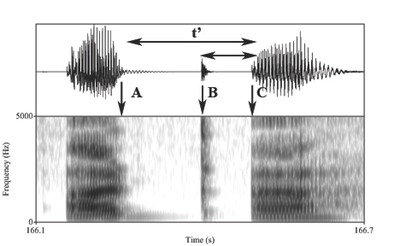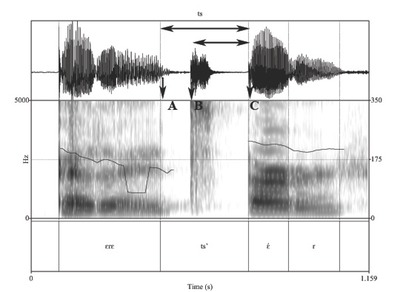Alveolar ejective stop t’-TsuuT’ina

Figure 1
The ejective sounds in the Dene languages have a characteristic and unique profile, visible in the waveform and spectrogram, and as an audible property of the sound.
These are the Dene ejectives:
t’ k’ tth’ ts’ ch’ tł’
Examples of these sounds are found through out the Dene Speech Atlas in all the languages.
Ejective sounds have two closures and two releases. The closures are simultaneous, this is indicated at point A in figure 1. The two closures at A are 1) closure at the larynx –a glottal stop- and 2) an oral closure, here an alveolar stop t. The air trapped between these two closure is compressed, so that when one of the closures is released, the oral one at B, the air is pushed out, resulting in a popping or clicking sound.
The releases of these closures follow each other. At B is the release of the alveolar gesture, the t gesture. At C, the glottal stop is released. In effect the glottal release is delayed, resulting in a longish period between B and C. The period between B and C after the burst, has been referred to as a ‘period of silence’. It is visible in the waveform and spectrogram.
Alveolar ejective affricative ts’-Dene Sųłine

Figure 2
In figure 2, the long arrow marks out the duration of the ejective affricate ts’ in Tsuut’inał the small arrow indicates the duration of the sound from the release of the oral gesture to the onset of the vowel.
This is characteristic of Dene ejectives. Hogan (1976) observed this aspect of ejectives in Dene Sųłine; Lindau (1984) observed it independently in Navajo and noted that this pattern was quite different from ejectives in other languages, such as those in the Bantu languages.
In a study by Wright et al (2004) on Witsuwit’in (in British Columbia), they also observed this pattern. However, they noted some interesting variability in the production of these sounds. Sometimes these sounds were realized without this delay and the resulting long release periods, which they called ‘weak’ ejectives. In a perception study, they found that speakers tended to mistake these ‘weak’ ejectives as the plain unaspirated stop d. We also find this type of variability in our data. Here is an example of a weak ejective in Dene Sųłine, example 2, bełk’ájá [bɛɬk'ɑ́dʒɑ́] “sleepy”. In this example the release of the oral gesure (B) and glottal stop (C ) of the ejective k’ follow each other closely. Compare this to this speakers other productions of ejectives. Of particular interst is that this ‘weak’ ejective can be mistaken for an unaspirated stop d, which it resembles.